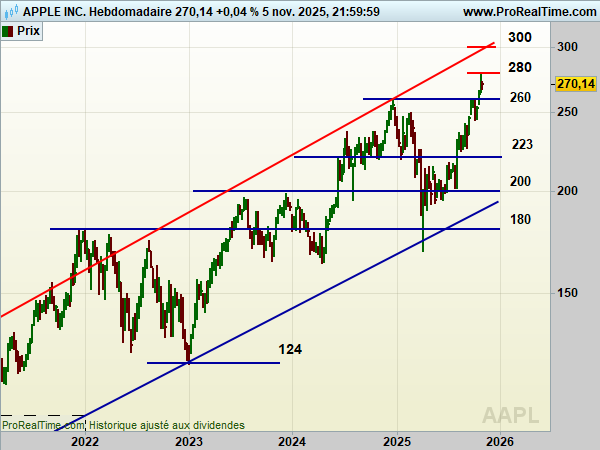Apple remains firmly anchored in a bullish trend, supported by exceptional fundamentals and a strong technical momentum that continues to attract investors. The stock is approaching a key resistance zone at $280, but retains upside potential toward $300 if this threshold is breached.
For several years, Apple shares have been moving within a remarkably steady ascending channel. Each upward phase has translated into steps of roughly $20, delivering an average annual return of nearly 16% over the past five years. Currently, the stock sits at the upper boundary of a rising wedge, suggesting technical resistance around $280. If broken, the natural target would be $300, corresponding to the top of the medium-to-long-term channel. Conversely, any pullbacks toward $265 or $260—or even $240—would represent attractive entry points for medium-term investors, although the latter level may no longer be revisited.
On the fundamental side, Apple’s latest earnings confirm the robustness of its business model. Fiscal Q4 2025 revenue reached $102.5 billion, up 8% year-over-year, with an all-time high in services at $28.8 billion (+15%). The iPhone remains the primary growth driver with $49 billion in revenue (+6%), while gross margins came in at 47.2%, beating expectations. Net income for the quarter hit $27.5 billion, and operating cash flow reached a new record of $29.7 billion. These results enable Apple to maintain a generous shareholder return policy, with $24 billion distributed last quarter, including $20 billion in share buybacks.
The earnings call highlighted several strategic developments. Tim Cook emphasized the growing integration of artificial intelligence across the Apple ecosystem, with features like Apple Intelligence, Live Translation, and a next-generation Siri expected in 2026. New products—including the iPhone 17 Pro, Vision Pro, AirPods Pro 3, and Apple Watch Ultra 3—demonstrate Apple’s undiminished capacity for innovation, while services continue to grow at double-digit rates, now exceeding $100 billion in annual revenue.
In terms of profitability, Apple boasts extraordinary metrics. Its ROE exceeds 150%, a figure that may seem extravagant. This is driven by a combination of exceptional operating profitability and aggressive share buybacks, which mechanically reduce accounting equity and inflate return on equity. In reality, economic profitability—measured by ROA around 30%—better reflects the company’s intrinsic performance. Even so, this remains an exceptional level among global large-cap stocks.
Valuation, however, remains demanding. The forward P/E for 2026 stands around 33x, with an EV/EBITDA near 25x—well above the sector average. The dividend yield is modest, at around 0.4%, as Apple clearly favors buybacks as its primary method of capital return. Yet with free cash flow generation exceeding $120 billion annually, the company enjoys unparalleled financial flexibility.
In conclusion, Apple combines favorable technical momentum with solid fundamentals. The $280 zone is a decisive test: a breakout would pave the way toward $300, while any pullback to $260–$265 would offer a compelling accumulation opportunity. In a market where few companies manage to blend innovation, profitability, and financial strength, Apple continues to stand out as a benchmark investment.
Analysis supported by fundamental data from Marketscreener.com (subscribe here).



